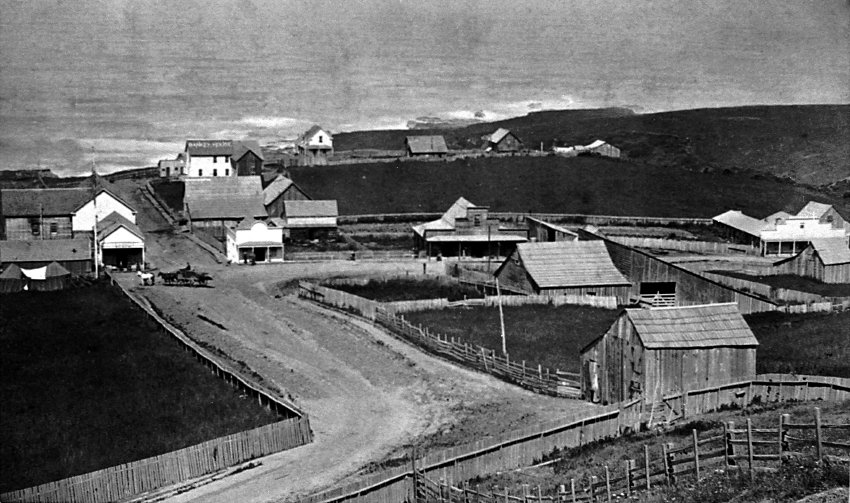
Village of Kibesillah in 1879. At one time, Kibesillah was one of the most important of the early north coast towns. First settled in the 1860s, the first business was a blacksmith shop in 1867. In its prime it had twenty to thirty buildings, including three hotels, three saloons, a public school and a Baptist church. Nothing of this is left – not even a sign to say where Kibesillah was located. (Kelley House Museum Photo Archives)
In the 1970s, the Mendocino County Historical Society sponsored the publication of “Reminiscences” by often unnamed old-timers. The Kelley House research library has many of these, including “Early Days on the Coast: True Accounts of Fort Bragg, Kibesillah and Vicinity.” No author was listed and “no responsibility was assumed for statements of facts.” It’s still fun reading.
The writer stated, “the mind of this old-timer goes back to 1870,” but I think these were tales that were told, retold, and embellished upon. The old-timer speaks of leaving Noyo (certainly before the 1870s), which had a post office, sawmill, toll bridge, hotel with the ever-present saloon, and a shipping point for windjammer schooners carrying lumber south. “It was the fag end of civilization.”
North one mile, a cluster of empty deserted buildings were once the headquarters of the Indian reservation, and in a field the unpretentious building was called The Fort. It and other structures had been abandoned in 1867. (Did you know there is still one remaining fort building today just north of the Fort Bragg City Hall on Franklin Street?)
Traveling north, the old-timer said, you came to a stream that on an 1855 map marked Duff River. Duff was a sailor’s term for Pudding – and the stream became Pudding Creek to locals. There were Indian reservation stations atop Bald Hills to the east, one just north of Ten Mile River, and trails lead from Pudding Creek to these locations.
Further north, great sand dunes covered the land for six miles and were constantly drifting over the roads. Arriving at the Ten Mile River, with no bridges or ferries, travelers waited for low tide and swam horse and rider across the mouth of the river. High rocky bluffs to the north were topped with a strip of great farmland that was a mile wide and extended ten miles north.
Three miles farther north you reached Kibesillah (a Native Pomo word). It was a tiny town with a store, blacksmith shop, two hotels and a school. The old-timer writes about local characters and town expansion that would include a shoe shop, a society hall with a band, a doctor, and a toll bridge over the river.
A sawmill required a lumber chute to load ships with lumber and passengers. A bigger hotel, with a dance hall, and sleeping and dining rooms, was added in addition to a harness shop, telegraph office, church and a weekly newspaper.
A man named C. R. Johnson purchased an interest in the lumber mill and upgraded its operations. Buying complete ownership over the years and making improvements, he needed a better shipping point. Johnson relocated the mill and lumber operations to Fort Bragg and founded the Union Lumber Company. When this happened, the whole town of Kibesillah, justice court and all, picked up and moved to Fort Bragg, too. Kibesillah became a “has been.”
The old-timer talked about the growth and improvements of Fort Bragg over the decades “…all night electric light sources, trained doctors and nurses, and fraternal societies galore.” He was very opinionated on what direction Fort Bragg should take, from parklands to street signs and sidewalks and cemeteries, and he talks extensively about the fight to establish a high school.
Historical Walking Tours of Mendocino can be booked at our website at https://www.kelleyhousemuseum.org/walking-tours/